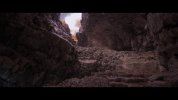yes, nanite for skeletal meshes is still in the experimental phase as of 5,5Really? UE5 games apparently use much more detailed character models, see HB2 or First Descendant.
You are using an out of date browser. It may not display this or other websites correctly.
You should upgrade or use an alternative browser.
You should upgrade or use an alternative browser.
Current Generation Games Analysis Technical Discussion [2024] [XBSX|S, PS5, PC]
- Thread starter Shifty Geezer
- Start date
davis.anthony
Veteran
In UE5 games 10X thanx Nanite.
But visually no where near 10x in a lot of games.
Doesnt feel or look like a serious jump in the polygon count this gen.But visually no where near 10x in a lot of games.
Yeah, increasing polygon count follows the law of diminishing returns. If we were coming from the days of Quake where enemies had hundreds of polygons, a 10x increase is absolutely amazing. Coming from tens of thousands or perhaps even a hundred thousand polygons to a million polygons still matters, but is it perceptible as the same "order of magnitude" difference? It's possible given a few interesting corner cases, but also seems unlikely.But visually no where near 10x in a lot of games.
At the same time, Nanite wasn't just about the visual fidelity jump. At least part of it was about artists being able to import incredibly detailed source objects, and having them "just work" in a game, in a performant way, without having to think through and enact a LOT of polygon pruning to get the asset down into what would be a reasonably performant lesser-polygon model when dealing with game engines which don't have nanite (or something similar.)
The geometry in the original UE5 demo still seems dramatically higher than any actual game. Doesn't seem like we are facing diminishing returns yet.Yeah, increasing polygon count follows the law of diminishing returns. If we were coming from the days of Quake where enemies had hundreds of polygons, a 10x increase is absolutely amazing. Coming from tens of thousands or perhaps even a hundred thousand polygons to a million polygons still matters, but is it perceptible as the same "order of magnitude" difference? It's possible given a few interesting corner cases, but also seems unlikely.
At the same time, Nanite wasn't just about the visual fidelity jump. At least part of it was about artists being able to import incredibly detailed source objects, and having them "just work" in a game, in a performant way, without having to think through and enact a LOT of polygon pruning to get the asset down into what would be a reasonably performant lesser-polygon model when dealing with game engines which don't have nanite (or something similar.)
Current UE5 games tend to look closer to tessellation displacement where as this demo looks like every single rock, pebble, ridge etc was individually modeled.
arandomguy
Veteran
Wouldn't this also come down to content authoring choices? I believe the UE5 demo's pulled assets from Quixel's asset library derived from photo scans.
I'm not sure if for game development you would really want to hand create original content to that level of detail.
I'm not sure if for game development you would really want to hand create original content to that level of detail.
I think we still very far from that. Graphics in games is not even near World of Warcraft CG movies level. Untill then I think improvements can bee seen very easy.Yeah, increasing polygon count follows the law of diminishing returns.
I changed my oponion about Stalker 2 a little bit. I think this game is with better graphics than Hellblade 2 in some aspects. In Stalker 2 there is a lot of small geometry even in some minor objects and there easily could be 20-30 minor objects in one scene. Haven't seen any other game yet with such high geometry level. Everything made very detailed and almost without polygons edges or without them at all. THis is true next-gen game. And all AAA games this gen should be on that level or at least near that level. Just incredible game.
It depends on the type of environment and scale. You can clearly see the differences in such a rocky environment. In some other environments you don't need so many polygons. With many Alan Wake 2 interiors way more polygons would not significantly enhance the visuals. In third person, you are also much further away from the objects and see much less detail then up close.The geometry in the original UE5 demo still seems dramatically higher than any actual game. Doesn't seem like we are facing diminishing returns yet.
Current UE5 games tend to look closer to tessellation displacement where as this demo looks like every single rock, pebble, ridge etc was individually modeled.
I've played Hellblade 2 twice and it often looks similar to the demo. It's not the technology that's limiting. The Unreal Engine 5 can render a lot of polygons. Some scenes in Hellblade 2 have the same amount of detail than some scenes there.
Last edited:
Says who? Says anybody who lives outside the weird freaking environment of this forum compared to any other gaming space. Says reality.MOD MODE: This thread is about Technical Discussion and Analysis surrounding Games. Want to complain about a mod? Create a new thread, or even better, send a note to Rys and let an admin review your complaint.
Back to me posting:
Says who? Using what logical measuring methodology? Given you're posting in this particular forum, there's a very high probability you have a full time job and a lot of adult responsibilities. Why are YOU more in touch with gaming versus people half your age who have neither of those burdens and thus more time to play games? Very likely the same population of people who would very rarely if ever post here.
This self-assuredness is misplaced, at best.
Is this another hilarious "I need data or your argument isn't valid" claim? lol
If you honestly and quite seriously think the people on this forum are remotely representative of the general gaming population, saying you are deluded would be an understatement.
Last edited:
In the end.. does it really matter what 100 random people think looks better? Artists see art very differently than the average person. We can all agree that it's subjective.. and this isn't the forum where "100 random people will agree with me" wins any arguments. 100 random people can be wrong. We're here because this is our own opinions and analysis.. and the argument can easily be made that either one looks better than the other, or is more impressive visually for whatever reasons.
If you honestly and quite seriously think the people on this forum are remotely representative of the general gaming population
I sincerely hope not! Have you seen the internet?
I was completely surprised by how detailed the geometry is in the battle royal game Off the Grid. It's not even noticeable beforehand, but when you take a closer look at the landmarks and the details, you really notice that some objects consist of almost infinite polygons. There is easily 10 times more detail compared to the previous generation. However, this is often only really visible up close. So we can say that, a lot depends on how designers use this almost infinite amount of geometry.It depends on the type of environment and scale. You can clearly see the differences in such a rocky environment. In some other environments you don't need so many polygons. With many Alan Wake 2 interiors way more polygons would not significantly enhance the visuals. In third person, you are also much further away from the objects and see much less detail then up close.
I've played Hellblade 2 twice and it often looks similar to the demo. It's not the technology that's limiting. The Unreal Engine 5 can render a lot of polygons. Some scenes in Hellblade 2 have the same amount of detail than some scenes there.
Isn’t it done for the source asset anyways? Developers with lower budgets would probably be better served just using the Quixel assets. Their quality is truly industry leading.Wouldn't this also come down to content authoring choices? I believe the UE5 demo's pulled assets from Quixel's asset library derived from photo scans.
I'm not sure if for game development you would really want to hand create original content to that level of detail.
I haven’t played Alan Wake or Hellblade, but from the DF videos, the geometry is a far cry from Lumen in the land of Nanite. Certain small props hold up but large scale environment objects and terrain are still quite lacking.It depends on the type of environment and scale. You can clearly see the differences in such a rocky environment. In some other environments you don't need so many polygons. With many Alan Wake 2 interiors way more polygons would not significantly enhance the visuals. In third person, you are also much further away from the objects and see much less detail then up close.
I've played Hellblade 2 twice and it often looks similar to the demo. It's not the technology that's limiting. The Unreal Engine 5 can render a lot of polygons. Some scenes in Hellblade 2 have the same amount of detail than some scenes there.
We're not just talking about the terrain, but about the thousands of objects in the games. These objects are extremely detailed geometrically with Nanite, even in current UE5 games.Isn’t it done for the source asset anyways? Developers with lower budgets would probably be better served just using the Quixel assets. Their quality is truly industry leading.
I haven’t played Alan Wake or Hellblade, but from the DF videos, the geometry is a far cry from Lumen in the land of Nanite. Certain small props hold up but large scale environment objects and terrain are still quite lacking.
Terrain and large scale objects contribute much more to the visual experience.We're not just talking about the terrain, but about the thousands of objects in the games. These objects are extremely detailed geometrically with Nanite, even in current UE5 games.
This cannot be stated clearly in this way, because for example several extremely well-crafted objects of normal size easily add to the visual spectacle, here is an example:Terrain and large scale objects contribute much more to the visual experience.

This is a very visible and very impressive details ingame.
I haven’t played Alan Wake or Hellblade, but from the DF videos, the geometry is a far cry from Lumen in the land of Nanite. Certain small props hold up but large scale environment objects and terrain are still quite lacking.
There is geometry everywhere. The engine can do that. The developers just have to apply it. I also don't know how much memory that much geometry requires.



Last edited:
I agree that we haven't seen anything as overall cohesive and geometrically detailed as Lumen in the Land of Nanite... but some games are already coming fairly close. As I believe was already stated, LitLoN uses movie quality assets, with extremely high quality texturing.. and made by some of the best Unreal Engine developers out there who specifically went hard to show what could be possible.. not what was necessarily feasible for a full scale game production at that point. I mean, I think Hellblade 2 and Black Myth Wukong are excellent examples of highly detailed geometric environments in games.. and from a distance they can look extremely similar, but when you start to look a lot closer, you can see where concessions had to be made, because these are large games with multiple worlds and varied assets.. not a singular level.
It's getting there though. Marvel 1943 Rise of Hydra looks insane and from what they've showed really holds up no matter where or how you look at it. So the first wave of UE5 games has come and gone, and the second wave using 5.3+ really look to be raising the bar.
It's getting there though. Marvel 1943 Rise of Hydra looks insane and from what they've showed really holds up no matter where or how you look at it. So the first wave of UE5 games has come and gone, and the second wave using 5.3+ really look to be raising the bar.
I don't understand the hate that nanite gets. Yah, it's not cheap, but it does pay off. I do think some of the best UE5 games are going to age very well, because nanite/vsms will scale incredibly well with resolution. I've mentioned it many times on here before, but I think UE5 games upscale much better because you have high geometric detail and higher detail shadows baked into frame, even if the resolution is low. Once new gpus start coming out that can push these games to higher resolutions etc, they're going to look pretty nuts. Or in my case, pushed to much higher frame rates.
I agree that we haven't seen anything as overall cohesive and geometrically detailed as Lumen in the Land of Nanite... but some games are already coming fairly close. As I believe was already stated, LitLoN uses movie quality assets, with extremely high quality texturing.. and made by some of the best Unreal Engine developers out there who specifically went hard to show what could be possible.. not what was necessarily feasible for a full scale game production at that point. I mean, I think Hellblade 2 and Black Myth Wukong are excellent examples of highly detailed geometric environments in games.. and from a distance they can look extremely similar, but when you start to look a lot closer, you can see where concessions had to be made, because these are large games with multiple worlds and varied assets.. not a singular level.
It's getting there though. Marvel 1943 Rise of Hydra looks insane and from what they've showed really holds up no matter where or how you look at it. So the first wave of UE5 games has come and gone, and the second wave using 5.3+ really look to be raising the bar.
Even Wukong. Some of the screens I've seen are wild.

Unreal Engine 5, [UE5 Developer Availability 2022-04-05]
Wukong has some pretty crazy geometric detail courtesy of Nanite in places.
I can't think of any game I've played that has a scene like these screens.
Similar threads
- Locked
- Replies
- 3K
- Views
- 289K
- Locked
- Replies
- 3K
- Views
- 304K
- Replies
- 247
- Views
- 16K
- Replies
- 3K
- Views
- 310K
- Replies
- 5K
- Views
- 552K
